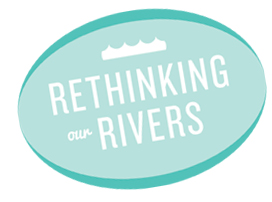Flexing Our Mussels
one of the region’s rarest, most fascinating residents
Bill Hogseth, photos by Andrea Paulseth |

On hot summer days, I put on a swimsuit and wade into the Chippewa River. As I slowly walk out, the water rises past my ankles and then up to my knees. The river wraps around my legs; the current tugs me sideways. My toes feel the shape of individual stones lying along the river’s floor. Then I consider the meaning of where I am standing. The bottom of this river is an entire world unto itself. Here, beneath my feet, along this gravel substrate, an ecological drama unfolds.
 It’s easy to forget about mussels. They live at the bottom of rivers and lakes. They don’t move around much. They don’t have legs or wings. They don’t make noise. To an untrained eye, their shells appear less than remarkable. Nonetheless, we owe these creatures acknowledgment for the services they provide, for their adaptations to life underwater, for their role in aquatic ecosystems, and for the troubles they face.
It’s easy to forget about mussels. They live at the bottom of rivers and lakes. They don’t move around much. They don’t have legs or wings. They don’t make noise. To an untrained eye, their shells appear less than remarkable. Nonetheless, we owe these creatures acknowledgment for the services they provide, for their adaptations to life underwater, for their role in aquatic ecosystems, and for the troubles they face.
Mussels (also called “clams”) spend their lives underwater, buried in the sediment of a river bottom. Mussels are filter feeders. They draw water in through a siphon, strain out free-floating microscopic organisms, digest them in their gut, and expel wastewater through an outlet siphon. Because of their filter feeding strategy, mussels contribute enormously to the water quality of a river. A healthy mussel population can filter many thousands of gallons of water per day.
To get around, mussels open their shell, stick out a muscly appendage (called a “foot”) and drag themselves along. They might travel short distances between areas of shallow and deep water, but they rarely go much further. Where habitat is good, mussels will pack together in dense concentrations and form “beds” of hundreds or thousands of individuals, often consisting of dozens of different species.
If they are not skillful movers, why don’t mussels occur in small isolated populations? How have these ostensibly immobile animals expanded their range? The answer is pretty surprising and it has to do with their reproductive cycle.
Male mussels send sperm into the water. Downstream, a female takes the sperm in through her siphon. Eggs are fertilized and the female raises a batch of microscopic mussel larvae on her gills. Not yet able to survive on their own, the youngsters – also known as glochidia – need some help before they face the trials of adult life. The female proceeds to spray her glochidia into the face of an unsuspecting fish. The glochidia clamp onto the fish’s gills and hitch a ride, all the while using tiny amounts of the fish host’s blood to grow their internal organs. After a couple of weeks, the glochidia release themselves into the river and commence the life of a mussel.
Mussels are well adapted to their riverine lifestyles. Sadly, changes in our waters are converging to threaten their livelihoods. Large river systems have become fragmented by dams, creating barriers between mussels and their fish hosts. Zebra mussels, a non-native species, have invaded regional waterways and are gradually overwhelming native species. Droughts can strand mussels on dry ground as water levels drop. More than half of Wisconsin’s mussel species – there are 51 in total – are listed as endangered, threatened, or special concern. “Native mussels are facing serious pressures from multiple directions,” commented DNR conservation biologist Lisie Kitchel. “If we lose our mussel populations, we also lose much of the capacity for filtration and water quality in our freshwater systems.”
Our very own Chippewa River is a mussel stronghold. Its extensive sand, gravel, and rock bars provide optimal habitat for 27 different species. Mussel congregations can be found throughout the river, from the city of Eau Claire down to its outlet at the Mississippi River. The Chippewa River is one of only 25 waterways in the entire nation that still holds the federally-endangered Sheepnose mussel. It has been considered a candidate river for the reintroduction of several other endangered species. Those of us who live in the Chippewa Valley share some of the responsibility for the fate of these animals.
While standing in the river, I crouch down and pluck a living mussel from the water. Holding it up, I watch its fleshy body writhe between the narrow opening of its shell. Because it lacks obvious appendages, such as a head or legs, I could think of the mussel as being a crude animal. But, that would be a mistake. The animal in my hand is tied closely with its environment – its ecology is synchronized with water chemistry, with floods and droughts, with the biology of nearby fish, and with the shifting sediments of the river bed. The animal in my hand is an achievement of evolution. I feel its spackled texture with my fingers. I heft its mass in my palm. Then, I toss it back into the water.
Bill Hogseth lives in Downsville, WI. He blogs at thinkinglikeavalley.com and tweets at @likeavalley.






















